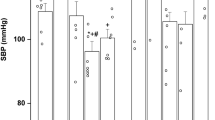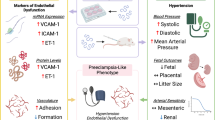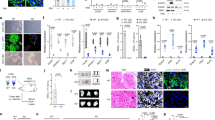Abstract
A substantial percentage of human pregnancies are lost as spontaneous abortions after implantation. This is often caused by an inadequately developed placenta. Proper development of the placental vascular system is essential to nutrient and gas exchange between mother and developing embryo. Here we show that α2-adrenoceptors, which are activated by adrenaline and noradrenaline, are important regulators of placental structure and function. Mice with deletions in the genes encoding α2A-, α2B- and α2C-adrenoceptors died between embryonic days 9.5 and 11.5 from a severe defect in yolk-sac and placenta development. In wildtype placentae, α2-adrenoceptors are abundantly expressed in giant cells, which secrete angiogenic factors to initiate development of the placental vascular labyrinth. In placentae deficient in α2A-, α2B- and α2C-adrenoceptors, the density of fetal blood vessels in the labyrinth was markedly lower than normal, leading to death of the embryos as a result of reduced oxygen and nutrient supply. Basal phosphorylation of the extracellular signal–regulated kinases ERK1 and ERK2 was also lower than normal, suggesting that activation of the mitogen-activated protein kinase (MAP kinase) pathway by α2-adrenoceptors is required for placenta and yolk-sac vascular development. Thus, α2-adrenoceptors are essential at the placental interface between mother and embryo to establish the circulatory system of the placenta and thus maintain pregnancy.
This is a preview of subscription content, access via your institution
Access options
Subscribe to this journal
Receive 12 print issues and online access
$209.00 per year
only $17.42 per issue
Buy this article
- Purchase on Springer Link
- Instant access to full article PDF
Prices may be subject to local taxes which are calculated during checkout






Similar content being viewed by others
References
Bylund, D.B. et al. International Union of Pharmacology nomenclature of adrenoceptors. Pharmacol. Rev. 46, 121–136 (1994).
Hein, L. Transgenic models of α2-adrenergic receptor subtype function. Rev. Physiol. Biochem. Pharmacol. 142, 162–185 (2001).
Hein, L., Altman, J.D. & Kobilka, B.K. Two functionally distinct α2-adrenergic receptors regulate sympathetic neurotransmission. Nature 402, 181–184 (1999).
Altman, J.D. et al. Abnormal regulation of the sympathetic nervous system in α2A-adrenergic receptor knockout mice. Mol. Pharmacol. 56, 154–161 (1999).
Link, R.E. et al. Cardiovascular regulation in mice lacking α2-adrenergic receptor subtypes b and c. Science 273, 803–805 (1996).
Link, R.E. et al. Targeted inactivation of the gene encoding the mouse α2C-adrenoceptor homolog. Mol. Pharmacol. 48, 48–55 (1995).
Zhou, Q.Y. & Palmiter, R.D. Dopamine-deficient mice are severely hypoactive, adipsic, and aphagic. Cell 83, 1197–1209 (1995).
Thomas, S.A., Matsumoto, A.M. & Palmiter, R.D. Noradrenaline is essential for mouse fetal development. Nature 374, 643–646 (1995).
Copp, A.J. Death before birth: clues from gene knockouts and mutations. Trends Genet. 11, 87–93 (1995).
Rossant, J. & Cross, J.C. Placental development: lessons from mouse mutants. Nature Rev. Genet. 2, 538–548 (2001).
Wang, R. et al. Expression of α2-adrenergic receptor subtypes in the mouse brain: evaluation of spatial and temporal information imparted by 3 kb of 5′ regulatory sequence for the α2A AR-receptor gene in transgenic animals. Neuroscience 74, 199–218 (1996).
Pohjanoksa, K. et al. α2-adrenoceptor regulation of adenylyl cyclase in CHO cells: dependence on receptor density, receptor subtype and current activity of adenylyl cyclase. Eur. J. Pharmacol. 335, 53–63 (1997).
Li, Y.W., Guyenet, P.G. & Bayliss, D.A. Voltage-dependent calcium currents in bulbospinal neurons of neonatal rat rostral ventrolateral medulla: modulation by α2-adrenergic receptors. J. Neurophysiol. 79, 583–594 (1998).
Surprenant, A., Horstman, D.A., Akbarali, H. & Limbird, L.E. A point mutation of the α2-adrenoceptor that blocks coupling to potassium but not calcium currents. Science 257, 977–980 (1992).
Schramm, N.L. & Limbird, L.E. Stimulation of mitogen-activated protein kinase by G protein–coupled α2-adrenergic receptors does not require agonist-elicited endocytosis. J. Biol. Chem. 274, 24935–24940 (1999).
Mikula, M. et al. Embryonic lethality and fetal liver apoptosis in mice lacking the c-raf-1 gene. EMBO J. 20, 1952–1962 (2001).
Giroux, S. et al. Embryonic death of Mek1-deficient mice reveals a role for this kinase in angiogenesis in the labyrinthine region of the placenta. Curr. Biol. 9, 369–372 (1999).
Wojnowski, L. et al. Endothelial apoptosis in Braf-deficient mice. Nat. Genet. 16, 293–297 (1997).
Wojnowski, L. et al. Craf-1 protein kinase is essential for mouse development. Mech. Dev. 76, 141–149 (1998).
Qian, X. et al. The Sos1 and Sos2 Ras-specific exchange factors: differences in placental expression and signaling properties. EMBO J. 19, 642–654 (2000).
Saxton, T.M. et al. Gene dosage–dependent functions for phosphotyrosine-Grb2 signaling during mammalian tissue morphogenesis. Curr. Biol. 11, 662–670 (2001).
Diamant, S., Eldar-Geva, T. & Atlas, D. Imidazoline binding sites in human placenta: evidence for heterogeneity and a search for physiological function. Br. J. Pharmacol. 106, 101–108 (1992).
Leimeister, C., Bach, A. & Gessler, M. Developmental expression patterns of mouse sFRP genes encoding members of the secreted frizzled related protein family. Mech. Dev. 75, 29–42 (1998).
Chomczynski, P. & Sacchi, N. Single-step method of RNA isolation by acid guanidinium thiocyanate–phenol–chloroform extraction. Anal. Biochem. 162, 156–159 (1987).
Sawamura, S. et al. Antinociceptive action of nitrous oxide is mediated by stimulation of noradrenergic neurons in the brainstem and activation of α2 adrenoceptors. J. Neurosci. 20, 9242–9251 (2000).
Zou, A.P. & Cowley, A.W. Jr α2-adrenergic receptor–mediated increase in NO production buffers renal medullary vasoconstriction. Am. J. Physiol. Regul. Integr. Comp. Physiol. 279, R769–R777 (2000).
Ceresa, B.P. & Limbird, L.E. Mutation of an aspartate residue highly conserved among G-protein-coupled receptors results in nonreciprocal disruption of α2-adrenergic receptor–G-protein interactions. A negative charge at amino acid residue 79 forecasts α2A-adrenergic receptor sensitivity to allosteric modulation by monovalent cations and fully effective receptor/G-protein coupling. J. Biol. Chem. 269, 29557–29564 (1994).
Bücheler, M.M., Hadamek, K. & Hein, L. Two α2-adrenergic receptor subtypes, α2A and α2C, inhibit transmitter release in the brain of gene-targeted mice. Neuroscience 109, 819–826 (2002).
Simm, A. et al. Advanced glycation endproducts stimulate the MAP-kinase pathway in tubulus cell line LLC-PK1. FEBS Lett. 410, 481–484 (1997).
Dieckmann-Schuppert, A. & Schnittler, H.J. A simple assay for quantification of protein in tissue sections, cell cultures, and cell homogenates, and of protein immobilized on solid surfaces. Cell Tissue Res. 288, 119–126 (1997).
Acknowledgements
We thank N. Schumacher, C. Arnolt, M. Babl and G. Wolz-Curtaz for technical assistance, and D. Drenckhahn for drawing our attention to abnormalities in the development of embryonic blood vessels in the placenta. This study was supported by the Deutsche Forschungsgemeinschaft.
Author information
Authors and Affiliations
Corresponding author
Ethics declarations
Competing interests
The authors declare no competing financial interests.
Rights and permissions
About this article
Cite this article
Philipp, M., Brede, M., Hadamek, K. et al. Placental α2-adrenoceptors control vascular development at the interface between mother and embryo. Nat Genet 31, 311–315 (2002). https://doi.org/10.1038/ng919
Received:
Accepted:
Published:
Issue Date:
DOI: https://doi.org/10.1038/ng919
This article is cited by
-
Crystal structure of the α1B-adrenergic receptor reveals molecular determinants of selective ligand recognition
Nature Communications (2022)
-
Dual Alpha2C/5HT1A Receptor Agonist Allyphenyline Induces Gastroprotection and Inhibits Fundic and Colonic Contractility
Digestive Diseases and Sciences (2016)
-
Immunohistochemical Localization of α2-Adrenergic Receptors in the Neonatal Rat Cochlea and the Vestibular Labyrinth
Journal of Molecular Neuroscience (2013)
-
α2-Adrenoceptors do not Mediate Neuroprotection in Acute Ischemic Stroke in Mice
Journal of Cerebral Blood Flow & Metabolism (2011)
-
The effect of clonidine on VEGF expression in human retinal pigment epithelial cells (ARPE-19)
Graefe's Archive for Clinical and Experimental Ophthalmology (2009)



